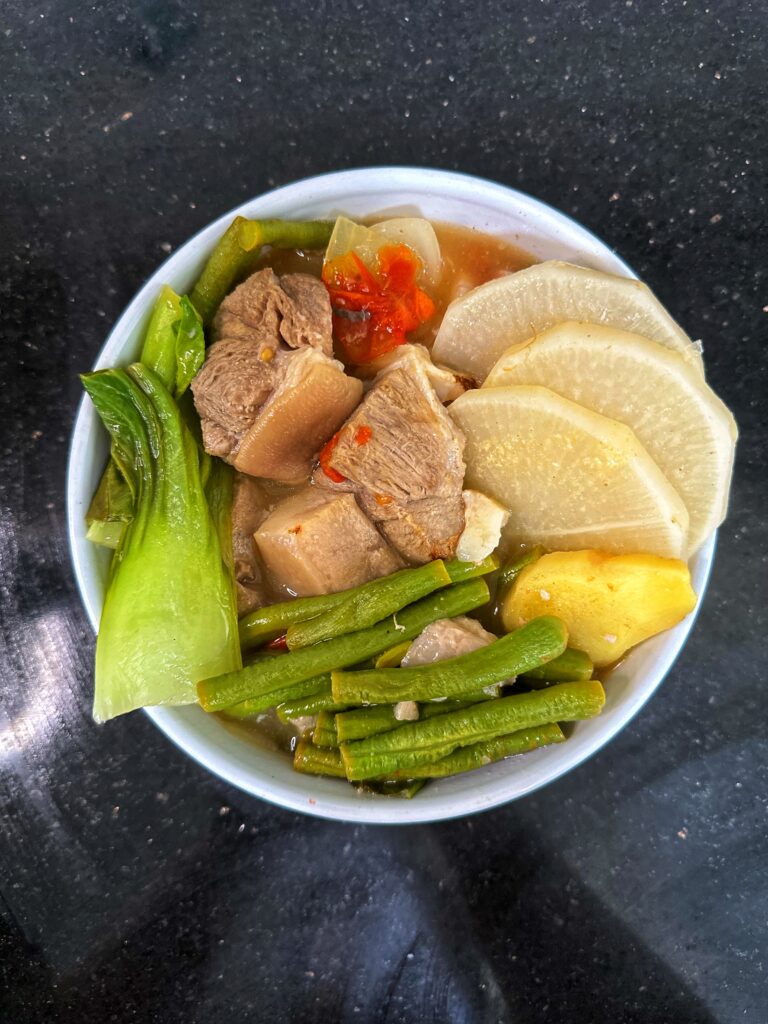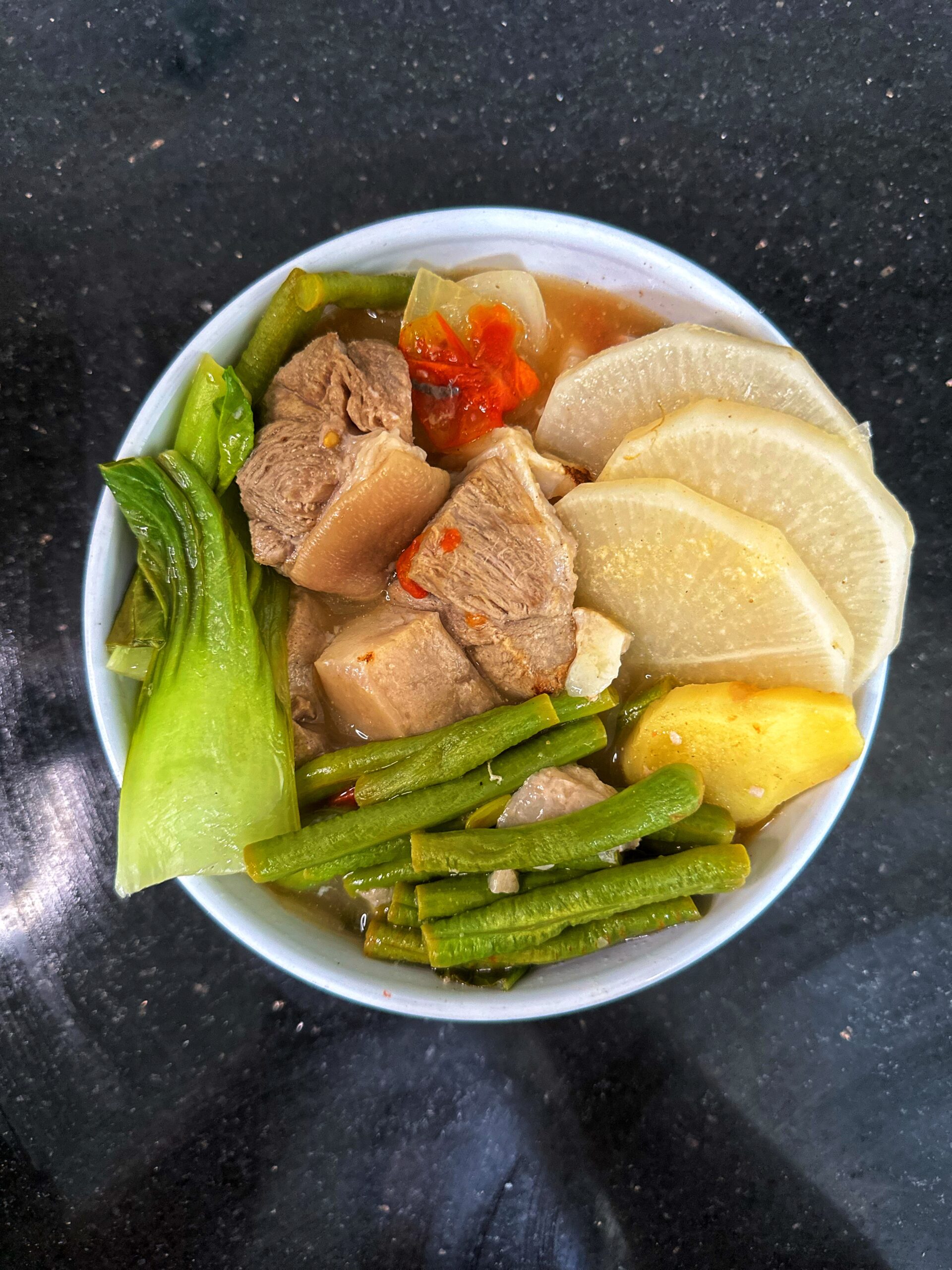Growing up in a Filipino household, pork sinigang was more than just a dish—it was a comforting constant, a warm hug in a bowl that never failed to bring our family together. I’ve made it so many times that I could whip up a pot without even thinking. But I realize not everyone might be as familiar with this dish as I am. So, let me take you on a journey through the tangy, savory world of pork sinigang.
The Origins of Sinigang
Sinigang is a traditional Filipino soup known for its sour and savory flavors. The word “sinigang” comes from the Tagalog word “sigang,” which means “to stew.” While its exact origins are unclear, it’s believed to have been influenced by the Malay dish “singgang” during the pre-colonial era.
What makes sinigang unique is its signature sourness, traditionally achieved using native fruits like tamarind, calamansi, or unripe mango. Today, many households (including mine) use convenient sinigang mix packets to get that perfect tangy flavor.
The Basic Ingredients
At its core, pork sinigang is a simple dish with a few key components:
- Pork: Usually ribs or belly for their rich flavor and tender texture.
- Souring agent: Traditionally tamarind, but sinigang mix is a popular modern alternative.
- Vegetables: Typically includes tomatoes, onions, radish, and leafy greens.
- Broth: A flavorful base that ties all the ingredients together.
In my recipe, I always include onions, tomatoes, and ginger as my flavor base. I believe these three ingredients add incredible depth to the broth.
Substitutions and Variations
One of the beautiful things about sinigang is its versatility. While pork is my go-to protein, you can easily substitute it with:
- Beef: For a richer, more robust flavor.
- Fish: A lighter option that’s popular in coastal regions.
- Shrimp: For a seafood twist that’s equally delicious.
As for vegetables, feel free to use what’s in season or available. Some popular additions include okra, eggplant, and long beans (sitaw).
The Perfect Pairing
In my household, sinigang is always served with steaming white rice. The rice not only helps to balance out the tanginess of the soup but also soaks up all those delicious flavors. Some people like to add a side of patis (fish sauce) for extra saltiness, but I find the sinigang flavorful enough on its own.
My Sinigang Journey
I’ve been making sinigang for so long that I sometimes forget not everyone grew up with it. It’s become second nature to me, a dish I can whip up without even thinking. But I’ve learned that what’s familiar to me might be new and exciting to others.
Over the years, I’ve perfected my recipe, striking the perfect balance between tangy broth, tender pork, and a medley of vegetables. My secret? I like my sinigang with some POW, you know? Like lip-smacking, mouthwatering pow. My sweet spot is one and a half packets of sinigang mix, but feel free to adjust to your taste.
Final Thoughts
Sinigang is more than just a soup—it’s a piece of Filipino culinary heritage, a dish that brings comfort and nostalgia with every spoonful. Whether you’re trying it for the first time or recreating a childhood favorite, I hope this recipe brings a taste of Filipino comfort to your kitchen.
Remember, cooking is all about making the dish your own. So don’t be afraid to experiment and find your perfect sinigang balance. Happy cooking!
Pork Sinigang Recipe

Pork Sinigang is a beloved Filipino soup that perfectly balances tangy and savory flavors. This comforting dish features tender pork and a variety of vegetables in a sour tamarind-based broth. What makes it so good is its ability to warm you from the inside out, with a lip-smacking sourness that’s both refreshing and satisfying. It’s a true taste of home that’s perfect for any day of the week.
Ingredients:
- 2 lbs (900g) pork ribs or pork stew meat, cubed
- 8 cups (2L) water, for cooking
- 5 cherry tomatoes, halved
- 1 thumb-sized piece ginger, sliced
- 1 medium yellow onion, quartered
- 1 large daikon radish, sliced into 1/4-inch rounds
- 1-2 packets Knorr sinigang mix, to taste
- 3 heads bok choy, roughly chopped
- 1 bundle snake beans (sitaw), cut into 2-inch pieces
- 1 tbsp Salt, for initial boil
Instructions:
- In a large pot, bring salted water to a boil over high heat then add pork. Cook for 1 hour or until meat is tender.
- Drain and rinse the cooked pork, discarding the cooking liquid.
- In the same pot, heat oil over medium heat. Sauté tomatoes, ginger, and onions for 1-2 minutes until fragrant. Add the cooked pork, 8 cups of fresh water, and daikon. Bring to a boil and simmer for about 20-30 minutes.
- Stir in sinigang mix packets to taste. Add remaining vegetables and cook for 1-2 minutes until just tender.
- Remove from heat. Serve hot with steamed white rice.
Enjoy your homemade Pork Sinigang, a bowl of comfort that’s sure to become a family favorite!

Be the first to comment